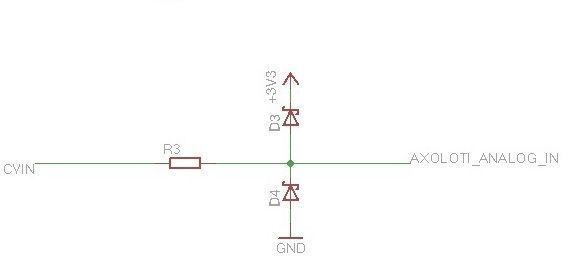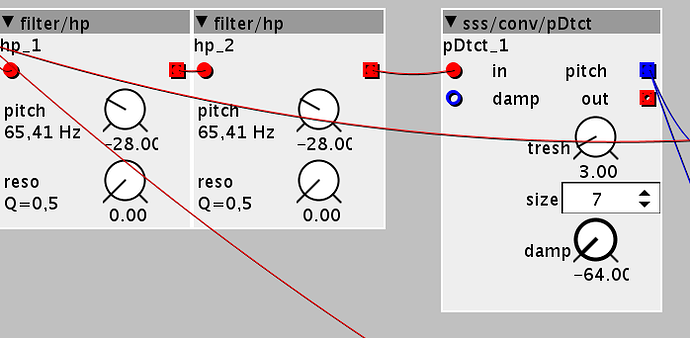I have a plan to do something very similar, but have been reluctant as it is a contradiction to some things I have said before.  I will get a guitar to midi converter to recognize the note being played, this will intern free up resources on an Axo. Will still analyze the audio in for conditions, but will add the note recognition of the guitar to midi converter as well. I did want to avoid this approach, I have considered many similar scenario's then those mentioned, but I do fear that I am missing out by compromising on not using one, and so this is why I have chosen to get one. From video's I have watched, it should more than meet my needs. For me it would cost the same as an Axo.
I will get a guitar to midi converter to recognize the note being played, this will intern free up resources on an Axo. Will still analyze the audio in for conditions, but will add the note recognition of the guitar to midi converter as well. I did want to avoid this approach, I have considered many similar scenario's then those mentioned, but I do fear that I am missing out by compromising on not using one, and so this is why I have chosen to get one. From video's I have watched, it should more than meet my needs. For me it would cost the same as an Axo. 
Polybass copy / guitar pickup to analog in
My initial plan was to do this on the teensy actually, since there is a pitch detection object already, and you could stack the audio shields to get more inputs.
Problem is I'm not a programmer and never worked with arduino so teensy is a bit undoable for me. Some of my friends are looking into the pitch detection on the teensy though.
If that would work I could do pitch detection + other sensors on teensy and hook it up to axoloti for the sound generation.
Which one do you have in mind?
Sonuus have a couple of options, they look realy good, as I will use a bass guitar it will need to be the B2M model. They seem reasonably priced too.
Several times a got real close to getting the teensy and audio shield, but don't think its worth it... !
sonuus are not the thing i think. better to buy a hex-pickup and a used axon for example. the best latency wise will be the fishman triple play. axon has the same logic in it though, just more clumsy...(the same guy programmed it) for bass to midi you are always gonna get noticeable latency on lower notes unless you go the fret sense way, which works but is expensive. i have tried them all 
in the end i still built myself a dedicated midi bass with ribbon strips and fsr's and i have never looked back!
sure, but in order to read them into the analog in you will have to bias the signals first, since the guitar signal is ac, and you want to avoid negative voltages on the analog ins. if you add the resistors for bias and some diodes for protection you are halfway to a full wave rectifier already, which basically is an envelop-follower 
Ok little update here, I tapped the lowest two strings from my Gk2, and made a digital priority that feeds into the pitch detection. It works quite well, but the pitch detection sometimes glitches when I play a low D (my guitar is tuned down a whole step)
It sometimes happens that the detection is confused and spits out fast moving random numbers until it settles to the right pitch. That makes it sound like a weird random glissando sometimes.
When testing before that wasn't as much of an issue. I guess it might be that the GK picks up more harmonics and attack sounds than the Neck Pickup that I used for testing before.
Any Ideas @SirSickSik how to improve detection on lower notes? Damping is how Is set the pitch detection:
Did you try the triple play? it looks good. All the other options are way too clumsy for the 21. century imho.
I don't need an acurate representation of the signal, I only need it to detect activity. So could I just clip the negative side of the signal?
sure, try it.
i know the designer of the triple play. it is really very good, the same as the axon system which i own but in a much smaller form factor.
very definitely. the gk pick up a LOT of harmonics, since they are so close to the bridge. again, i have done this in puredata land with six audio channels. what you want for your approach is some heavy filtering and you set the cutoff based on the analog input readings. i would suggest a cutoff around the 10th fret of the played string. it should be easy to switch the lp filter frequency if you get consistent readings from the analog ins.
May have to rethink the Sonuus then... 
I'll check out some Arduino projects, and maybe I should implement one of my old ideas to add LDR's to an old analog Guitar tuner, the ones that have LED's light up when the string is tuned..
sounds like fun! probably easier to directly hook the led output to a digital in. note though, that latency will again be horrible, the tuner is not optimised for speed. also, you don't get the correct octave from the led, but maybe that is not important. do you mean a real old tuner, with a hand (like on an old stereo or something) or what makes you think it is analog?
Old because it reminds me of the ones I could buy 25 years ago, runs on a 9v bat.
It has an led for each string, and 3 extra led's green one in the middle, red on either side to help you know when you have it tuned. I know there is going to be latency etc, but considering I have a plethora LDR's and a few dev boards, no hassle to frig around with it. I was wondering though whether I could hack it to recognize the full chromatic. But it is on the back burner till I finish my home made midi controller. (a couple of weeks).
One thing I was reading about last night, was a few attempts people have made to use the guitar string and frets as a switch trigger. The problem they all seem to have is setting up with the switch trigger as well as the normal pickups running at the same time. There must be a way around it somehow. I am wondering whether there is a way of taking advantage of the normal guitar grounding as part of the signal flow rather then isolating like most do.
do you mean like industrial radio midi bass for example? that is a nice solution (i have one) but for best results you will have to divide your frets in six parts to get a switch for every string.
Maybe, maybe not, there are a few different type attempts, you can get good enough monophonic results without dividing the fret. But they seem to get mixed results when wanting to use the pickup as well.
My thoughts are kind of towards, lets say for example the guitar is plugged directly into the Axo, so the guitars ground and Axo are now linked. But the guitar ground wire will have a 1k resister on it. Resister differential is added to the strings at the guitar head so the voltage is split to different levels by the resistors down each string. Each fret is connected to an analog input. So when no string is press against a fret, they are all grounded, but when the string connects to the fret, the signal follows the path of less resistance send a voltage level to the analog inputs, therefore giving a reading of fret and string. And at the same time, the audio is still going into the Axo for normal play etc..
Well its just an idea for now... 
yeah for monophonic that could work.
but an analog in per fret seems like a waste. better to go one analog in per string. then connect resitors between each fret and so you get a different reading for every fret you press down. (that's how it is done in commercial products) hmm, but multiple strings on the same fret pressed down could be an issue then...(again, what commercial products mostly use, except for frettrax, but they have no open string detection as of now, no velocity)
Do you know how I would do that? So for voltages above 3.3V i put a zener diode, what do I do for negative voltages?
according to this article (scroll down to the last bit) a single zener should suffice...
https://www.electronics-tutorials.ws/diode/diode-clipping-circuits.html
Thx!! So I guess I could use a 3.3V zener diode and a schottky diode for the negative range?
Little Update here:
I found a dual output dc converter that I hooked up to the 5v axoloti pins to generate +-9v for the GK.
Officially the GK takes 7V but seems to be working fine on 9v.
The Bass patch works great so far, although I need to work on my priority/string detection logic.
Next will be to use the pot and the swtiches on the GK to do Subbass volume and patch changes.
I measured that the pot puts out 6.5V when open. Way too much for axoloti. How would I scale this down?
I found this in the Euxoloti thread. Would it work for this application? Does anybody know which value r3 has to have for scaling down 6,5V to 3V?
I'm a real noob with this electronics stuff. So just a 3.3V zener is enough to clip all voltages to a 0-3.3V range?
In the example you send me there is still -0,7V going through, or is that dependend on the diode you use?
For 6.5V CV from the GK pot I built a simple voltage divider using two resistors. Works like a charm. I want to add diode protection here too though, just to be shure.
Hey everybody!
I was recently messing with octave down patches (my octave pedal died recently, it's a sad time for my hardware family https://sebiik.github.io/community.axoloti.com.backup/t/man-vs-midi-controller/6307/5) and found this old thread...
@Blindsmyth did you manage to make the low.note priority bass?
I made and used quite a lot a kind of BOSS oc-3 emulation using @lokki's objects, here's the patchoc-3.axp (58.1 KB)
I suspect the oc-3 works in a similar way, monophonic analogue-style octave generation for band-passed signals, instead of pitchshifter approach.
I was now trying to have it be low-note priority, and I came up with two approaches.
Here come the patches
1priority.axp (34.0 KB)
bandpriority.axp (31.3 KB)
They both kinda work, far from perfectly.
I'd love to hear what you guys think!
Cheers
UH, be careful with the noise gate threshold and the low-priority threshold, they might be set very differently with different pickups/instruments

